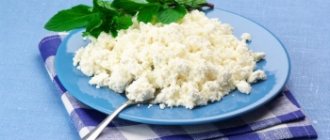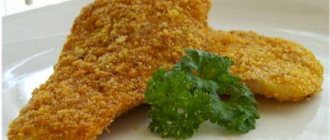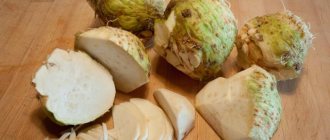Five reasons why this product should have a place in your refrigerator, and three easy recipes using coconut milk.
Coconut milk is an underrated product in our latitudes. It is known mainly as an element of exotic Thai cuisine and a number of diets that involve the abstinence of certain foods of animal origin. In this case, coconut milk is an alternative to the usual cow's or goat's milk, cream or sour cream.
However, a delicate creamy drink with a slight sweetish taste has much more beneficial properties than just the ability to replace fermented milk products. Life hacker found out everything about the health benefits of coconut milk.
Benefits of coconut milk
First, let's define the concepts. Coconut milk is not at all the same water that splashes inside a whole tropical nut. That liquid is called coconut water, consists of almost 95% water itself and contains practically no fat or other nutrients.
Milk is a mixture of coconut pulp and water carefully processed to a homogeneous mass. Lifehacker has already written about how you can make coconut milk yourself.
The result is a high-calorie product with a high content of polyunsaturated fatty acids, vitamins and microelements. So, after drinking one cup (240 ml), you will receive Coconut Milk Health Benefits and Uses:
- 552 kilocalories;
- 57 g fat;
- 5 g proteins;
- 11% Daily Value of Vitamin C;
- 22% Daily Value for Iron and Magnesium;
- 18% Daily Value for potassium;
- 21% Daily Value for Selenium.
In addition, you will completely cover the body’s daily need for manganese. Here's what this fatty-vitamin-mineral cocktail does to your health.
You are losing weight
For many, the word “fat” evokes a strong association with excess weight, but in this case, fats, on the contrary, contribute to weight loss. Sounds absurd? No.
Coconut milk contains mainly polyunsaturated fats (including the famous essential omega-3, omega-6 and omega-9), which are very beneficial for metabolism. But that's not all. About half of all fatty acids are lauric acid. This substance belongs to the category of so-called medium-chain fatty acids, which have one unique feature: from the digestive tract they go straight to the liver, where they are immediately used to produce energy or ketones (these substances are the main “fuel” for the brain).
Therefore, coconut fat has much less chance of turning into fat reserves - the body uses The Properties of Lauric Ac > it almost instantly.
You get smarter and more productive.
This is how the already mentioned polyunsaturated fats omega-3, omega-6 and omega-9 work, as well as lauric acid, an energy supplier for the brain.
You boost your immunity
You improve heart and cardiovascular health
Coconut milk reduces the risk of cholesterol plaques on the walls of blood vessels. Moreover, this effect is so noticeable that scientists talk about good prospects for using coconut milk in the dietary nutrition of cardiac patients.
You improve the condition of your skin and hair
Coconut milk has a beneficial effect on our body not only internally, but also externally: for example, Lifehacker has already written about how omega-3 and omega-6 fatty acids from food affect the level of skin hydration.
The antimicrobial and antiviral activity of lauric acid also extends to the treatment and prevention of all kinds of skin diseases: from eczema to herpes. Milk can be used as a mask for hair and skin or added to your usual cosmetic products - for example, nourishing body cream.
Here is a video in which the famous American nutritionist Bruce Fife, president of the Coconut Research Center in Colorado Springs (USA), tells everything about how the fats contained in coconut milk affect appearance.
Whole milk, skim milk, oat milk, coconut milk: which is healthier? Nutritionists explain
Just a few decades ago, the only thing we could top our cereal with was whole cow's milk.
Now there are many varieties of this drink: low-fat, lactose-free, soy. For people with allergic reactions, there are also plant-based alternatives to cow's milk (it's Lent, so the topic is more relevant than ever): almond, oat, coconut. SPLETNIK.RU, together with expert nutritionists, finds out which one is healthier. For a long time, health advocates insisted that the fat found in dairy products was harmful. For several decades, milk was considered enemy number one due to the fact that it is quite high in calories (one glass of milk contains about 120 kcal) and with age, lactase production in humans decreases, so it is simply not absorbed by the body. However, whole milk and no-sugar-added yoghurts are now again being hailed as healthier foods compared to their low-fat counterparts.
Back in the 1990s, the main recommendation from dietitians was to reduce fat in the diet, including the fat found in milk, explains Frances Largeman-Roth, nutrition expert and author of Eating in Color. ).

As more people choose low-fat yogurts and cottage cheese, manufacturers have begun adding heavy doses of sugar and artificial ingredients to their products to enhance their flavor. Result? One serving of seemingly “harmless” strawberry yogurt contains your daily sugar intake. Skim milk and flavored yoghurts not only don't make you feel full, but they're also high in sugar and don't have any health benefits, says Frances.
The main disadvantage of low-fat dairy products is that they are not balanced in fat and carbohydrates. It is believed that calcium is less absorbed from such products - this requires fats, which are deprived of the composition. It is better to choose milk with an average fat content of 2.5,
— says Galina Anisenya, World Class nutritionist.
Whole milk
Whole cow's milk contains about 88 percent water, five percent lactose (carbohydrates), three percent fat, three percent protein and less than one percent minerals. The composition of milk depends on the breed of the cow (for example, Holstein-Friesian or Jersey), the animal's diet and the stage of lactation. Cow's milk contains nutrients such as vitamins B, C, D, niacin and folate (folic acid) and bone-strengthening components.
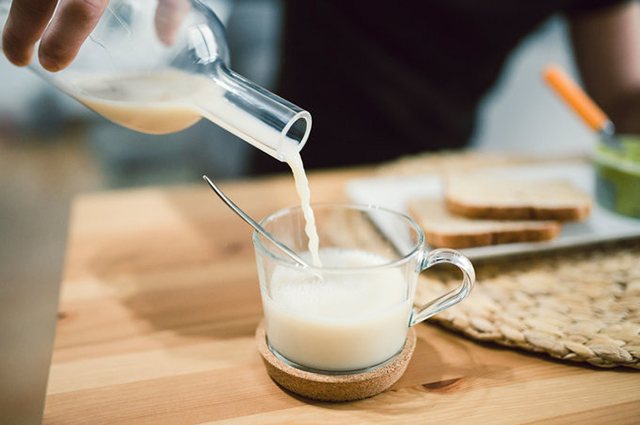
Previously, milk had no alternative, but over time new types of this drink appeared. Surprisingly, full-fat dairy products can actually help you maintain a lean figure, says Largeman-Roth.
She cites a study of 18,000 middle-aged women of normal weight. They found that those who drank whole milk and ate full-fat dairy products were less likely to be overweight or obese later.
A small study published in the European Journal of Clinical Nutrition also found that daily consumption of whole milk increased HDL (or good cholesterol) levels, while daily consumption of skim milk did not.

But there is another opinion. Thus, nutritionist Cassie Bjork explains that milk has a high insulinogenic ability, which means that it increases blood sugar levels. It also causes inflammation, causing acne, eczema, rosacea and digestive disorders.
We don't need cow's milk and get the same nutrients from meat, seafood, vegetables, fruits and nuts. If you don't drink milk because of the hormones and antibiotics given to cows, it's best to buy plant-based alternatives, says expert and founder of Healthy Simple Life.
Many believe that adults over 30 years old should not drink cow's milk. Apparently it is poorly absorbed. However, Galina Anisenya is sure that age cannot serve as a criterion for deciding whether or not to drink cow's milk: Saying that the adult body does not absorb cow's milk, many give the following argument: animals feed on milk only during the feeding period after birth. Soon their diet changes, but this is how nature intended; if animals could continue to receive milk, this does not mean that they would not eat it. When choosing milk, we again rely on the individual characteristics of a person. If he has lactase deficiency (lactase is an enzyme that is needed to digest the milk sugar lactose), then drinking cow's milk can really be a problem.
If you have allergic reactions to casein, then you can switch to goat's milk, it contains casein in small quantities. It contains mostly albumin, which is smaller in structure, making it easier to digest.
Lactase deficiency can be genetically determined or acquired lactose intolerance, which can occur even against the background of severe stress. If the body begins to produce less of the necessary enzymes due to health conditions, then the person will experience discomfort when drinking milk.
You need to understand that alternative milk of plant origin is not milk in full, it only superficially resembles it in its liquid consistency and light shade. And it is recommended to use it as a replacement if there really are individual problems such as lactase deficiency. If there is no such problem, it is worth remembering that ordinary cow’s milk, for example, has the most optimal ratio of calcium and phosphorus for absorption in the body and will serve as a source of useful substances.

Lactose-free milk
Lactose-free milk has almost the same texture and nutrients as regular milk. For people with lactose intolerance, regularly drinking lactose-containing milk can cause digestive problems such as abdominal pain, bloating, diarrhea and belching. This milk tastes sweeter than regular milk. This is because of lactase, an enzyme added to lactose-free milk that breaks down lactose into two simple sugars: glucose and galactose.
There is no allergy to lactose. Intolerance happens, and it manifests itself in different ways. You may feel discomfort and notice a reaction from the gastrointestinal tract through bloating and “grumbling”, but the picture can be blurry - fatigue and irritability may be added to the unpleasant sensations. If lactase deficiency is severe, then the gastrointestinal tract will not accept the product,
- says World Class nutritionist.
If you suspect that milk is the culprit of your discomfort, you can keep a food diary and, by eliminating dairy products completely for a while, note changes in your well-being. If it improves significantly, then it is really worth removing it from the diet. And genetic testing can give you the most accurate results.
Soy milk
According to nutritionist David Friedman, soy milk was the first alternative to cow's milk to hit the market. Thanks to its nutrients, it is an excellent source of energy, protein, dietary fiber, fats, and acids. Soy milk contains all nine essential amino acids. The body stores them and converts them into new proteins, including antibodies, necessary for the immune system to function. Structural proteins help replenish energy reserves, explains Ekaterina Agapova, chef at Holy Basil Cafe.
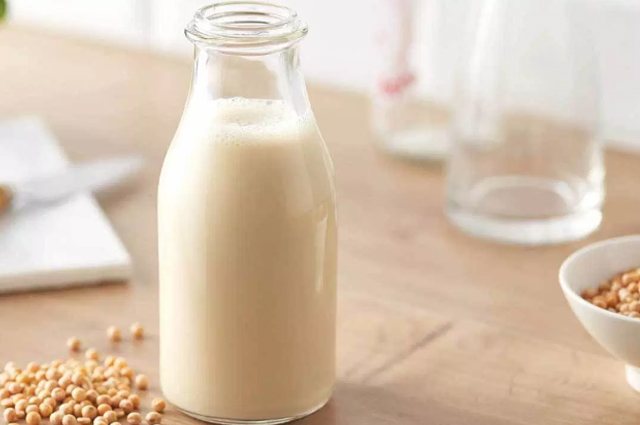
This is a great option for those who are allergic to dairy or lactose intolerant (in fact, only six percent of children and one to two percent of adults have an actual food allergy) or simply aren't crazy about the taste of milk.
However, too much soy may not be good for people with thyroid disease. A 2008 Harvard study found that high consumption of soy products causes fertility problems and lower sperm counts. Soy is also a common allergen.
Plant-based milk can now be bought in almost any store with different flavoring additives, or you can prepare it yourself at home and control the whole process. For this you will need: soybeans and water.
First, the soybeans need to be washed and soaked for 12 hours. After soaking, they should increase in size and become softer. Before preparing soy milk, remove the thin skin from the beans, which can be easily removed after soaking in water. Cleaned soybeans must be placed in a blender and filled with water. Chop the beans thoroughly and mix with water until smooth. The next step is to strain the soy milk and remove the remaining beans through cheesecloth or a special bag for nut milk. Place the strained milk on low heat and bring to a boil. If desired, you can add salt, dates or Jerusalem artichoke syrup, stevia or any other sweetener: vanilla stick or vanillin.
Then cook the soy milk over low heat for 20 minutes. Then remove it from the heat and cool. Once the soy milk has cooled, remove the film from the surface with a spoon. Now homemade soy milk is ready to drink.
Nut milk is prepared in the same way, but does not require boiling; such milk can be stored for only two to three days, but it is better to eat fresh, says Ekaterina Agapova.
The water in which the nuts are soaked saturates them with nutrients. In this form, nuts are much better absorbed by the body. The benefits of a particular nut drink will vary, because each nut contains its own unique set of various vitamins and minerals. Based on this, we can say with confidence that these drinks have a large number of beneficial properties and are thus an excellent replacement for cow's milk. By the way, you can make cheese from the remaining cake from beans and nuts or use it for baking. You can also dry nut cake with Jerusalem artichoke syrup or honey and add it to porridge.
Cashew milk
Nutritionist Michelle Dudash says she loves the creamy taste of cashews. According to her, one glass of this milk contains four grams of protein and eight percent of the daily value of iron.
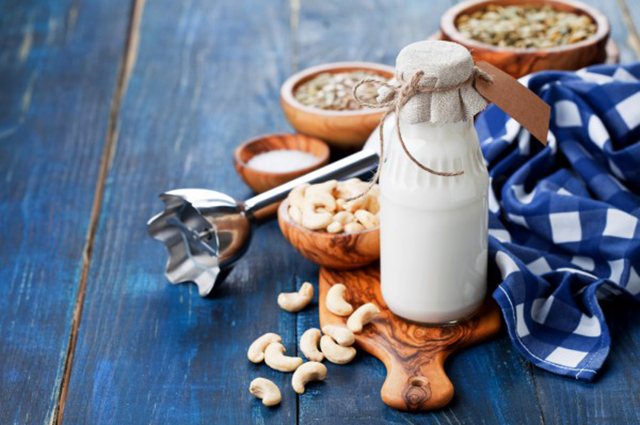
However, keep in mind that one serving also contains half a teaspoon of cane sugar. If you're limiting your sugar intake, consider other options, warns Dudash.
Almond milk
Like soy milk, original and sweetened almond milks contain cane sugar. Almond milk has a sweet, nutty flavor and a silky texture. It is rich in vitamins D, E and A and minerals: calcium, magnesium, potassium, zinc, iron and phosphorus. The fat in almond milk is heart-healthy because it contains monounsaturated and polyunsaturated fats, which studies have shown to protect against coronary heart disease.

Good news for those losing weight - almond milk contains fewer calories than other types of milk, but it does not contain as much calcium as we would like. Almond milk is easy to make with dried almonds and water, although you can add other ingredients, such as a pinch of sea salt or half a teaspoon of vanilla extract. But packaged milk can also contain starch and thickeners to improve its consistency and shelf life. And do not forget that if you are allergic to almonds or nuts, then it is better to avoid this drink.
Coconut milk
This type of milk (not to be confused with coconut water, which is the liquid inside the young coconut palm) contains more saturated fat than other types. It has a creamy consistency and a pleasant taste. Coconut milk is obtained artificially from the pulp of a ripe tropical fruit, adding water, salt, a thickener (most often based on carob), an emulsifier such as sunflower lecithin, and vitamins and minerals (calcium, vitamins A, B, C, E, D).
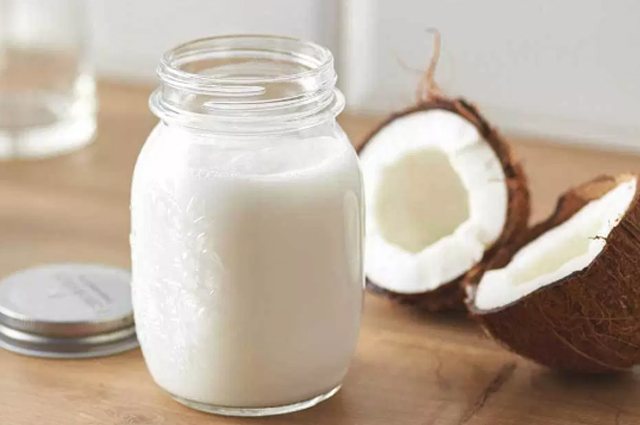
Even though coconut milk is higher in calories than cow's milk, it is believed that the oils and fatty acids it contains are easier for the body to absorb.
Oat milk
A vegan favorite is oat milk. Preparing it is as simple as cooking oatmeal: you just need to pour a lot of water over the oatmeal (the ratio is one to three), grind it in a blender, strain - and you’re done. The drink has a slightly sweet taste and is rich in protein (about four to five grams per serving) and fiber. However, oat milk should be avoided by those on a gluten-free diet.
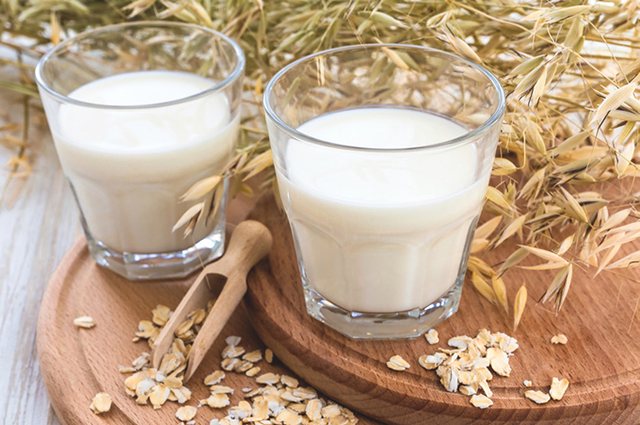
Hemp milk
Perhaps the rarest type of milk that can be found in our country. It is made from hemp seeds. However, hemp milk, flour and baking additive do not contain tetrahydrocannabinol (or THC, a substance derived from marijuana).
Lewis Friedman, a registered dietitian who teaches part of Dr. Campbell's plant-based nutrition course, says a glass of hemp milk provides 45 percent of the recommended daily value of calcium. It is also rich in heart-healthy omega-3 fatty acids. Research shows that consuming fatty acids may help control cholesterol levels and blood pressure.
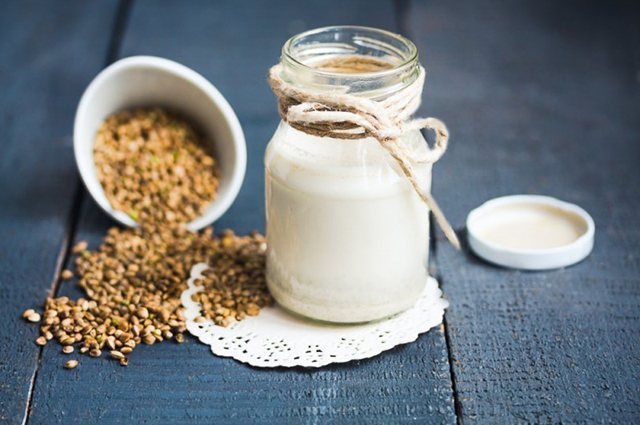
However, the main thing is not to overdo it. If you tolerate dairy well, stick to the recommended three servings per day.
You can pour a glass of milk over your oatmeal, then eat yogurt as a post-workout snack, and then eat a couple of slices of cheddar cheese in the afternoon.
- says the expert, adding that dairy products are an excellent source of calcium (the daily requirement for women is about a thousand milligrams).
Also keep in mind that Greek yogurt has very little lactose, and hard cheeses do not contain lactose at all.
What kind of milk do you prefer?
What to cook with coconut milk
Below are three incredibly quick, easy and budget-friendly recipes.
Carrot-coconut soup
Even a child can prepare this simple and at the same time original dish. This soup will be a good solution if you are following a fast or a vegetarian diet.
Ingredients:
- 3 carrots;
- 200 ml coconut milk;
- 400 ml water;
- 2 tablespoons lemon juice;
- 1 teaspoon turmeric;
- salt and ground black pepper to taste;
- parsley or basil for decoration.
Preparation
Peel the carrots, rinse in running water, cut into slices. Place in a saucepan, add water, bring to a boil. Then simmer over low heat until the carrots are soft.
Without turning off the heat, add turmeric, coconut milk, salt and pepper. Stir, reduce heat to low and cook for another 2-3 minutes.
Remove the soup from the heat, add lemon juice and blend with an immersion blender until smooth. Pour into plates and garnish with coarsely chopped herbs. To add more flavor to the soup, you can add 1 teaspoon of soy sauce to each bowl.
Chicken in coconut milk with spices and mango
This is one of the most popular Thai dishes and is easy to prepare yourself.
Ingredients:
- 3 chicken breasts without skin;
- 250 ml coconut milk;
- 1 peeled mango;
- 1 peeled small carrot;
- 1 medium sized onion, peeled;
- 1 fresh chili pepper;
- 2 cloves of garlic;
- 1 cm fresh ginger root;
- 1 teaspoon curry powder;
- 1 teaspoon soy sauce;
- 2 tablespoons vegetable oil;
- salt to taste.
Preparation
Cut the onion into rings and fry in oil in a large frying pan until soft. Add the chicken cut into large cubes and fry over high heat until the pieces are browned on all sides.
Cut the mango and carrots into large cubes and add to the chicken. Reduce heat to medium, cover the pan and let the ingredients simmer for 3-4 minutes.
Chop the garlic, ginger, chili pepper with a knife and add to the pan with the chicken and mango. Add curry, salt, mix well, pour in coconut milk, bring to a boil. Turn off the heat, cover the pan with a lid and let it cool.
Serve in deep bowls, adding soy sauce to each to taste. The ideal side dish for spiced chicken is boiled rice.
Coconut cocktail with strawberries
Thanks to the addition of coconut milk, the taste of a traditional milkshake becomes deeper and more interesting, acquiring an exotic touch. If for some reason you do not consume traditional dairy products (say, due to lactose intolerance), the cow's milk in this cocktail can be completely replaced with coconut milk or water.
Ingredients:
- 400 ml coconut milk;
- 200 ml cow's milk;
- 80 g brown sugar;
- 200 g fresh strawberries;
- 20 g coconut flakes;
- ice cubes if desired.
Culinary Use: Recipes with Coconut Milk
Coconut milk is widely used in East Asian cuisine. Delicious soups are cooked on its basis, sauces, desserts, baked goods, drinks, salad dressings, stews, etc. are made. Today, the culture of using milk has spread throughout the world.
The scope of use of plant milk is wider than that of a product of animal origin, since it does not curdle when heated and combined with acidic ingredients. In Thai dishes it is often used together with seafood - the result is an excellent flavor combination. In addition, sweet sauces for beef or poultry meat are prepared from this milk. It gives dishes a sweetish creamy taste and velvety coconut aroma.
What can you successfully combine coconut milk with:
- poultry, fish, meat;
- rice and pasta;
- cream and milk of animal origin, fermented milk products;
- vegetables (especially sweet ones);
- tropical fruits;
- dried fruits;
- berries.
In most cases, this product can successfully replace cow's milk. It makes good pancakes, casseroles, porridges, and desserts. In Thailand, a very popular side dish is rice cooked in this milk. People with lactose intolerance or those on a dairy-free diet can drink coffee with coconut milk. This does not reduce the benefits of the main drink; it retains its tonic properties. Moreover, the drink takes on a pleasant taste, as if coconut syrup had been added to it.
Oatmeal with coconut milk
This dish is great for those on a gluten-free diet or suffering from celiac disease. For preparation, you can take a standard jar with 400 ml of milk. For this volume you need to take a glass of oatmeal and a tablespoon of honey and walnuts.
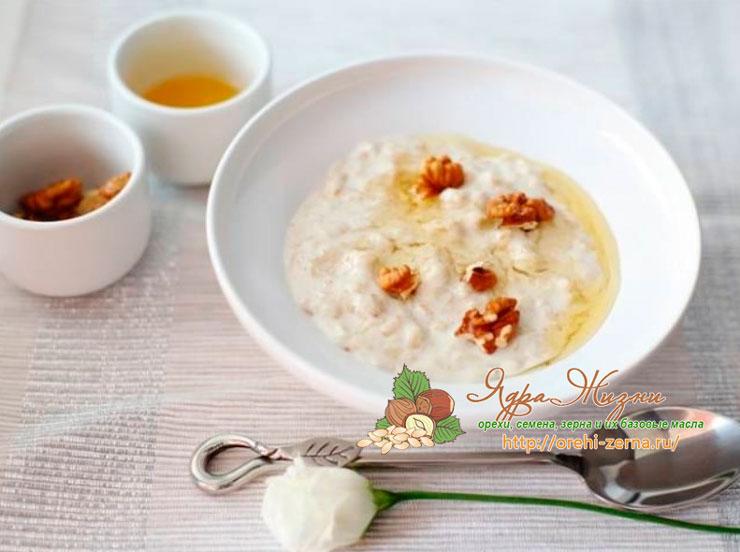
Oatmeal with coconut milk
Preparation procedure:
- Mix milk with an equal amount of water in a saucepan and place it on the stove.
- After the liquid boils, add the flakes.
- Cook according to the instructions for the flakes or to your taste, stirring constantly with a spoon.
- When ready, add butter and walnuts.
Traditional Thai soups
Coconut milk-based soups are very popular in Thailand and are one of the hallmarks of Thai cuisine. During cooking, the milky liquid is mixed with fish, meat or vegetable broth and a base in the form of meat or seafood.

Thai soup Tom Yam Kha Kung
To prepare Tom Yam Kha Kung (shrimp soup) you need:
- coconut milk – 400 ml;
- peeled shrimp – 450 g;
- champignons – 200 g;
- ginger root – 3-5 g;
- garlic - two cloves;
- tomatoes – 2 pcs.;
- sugar – 1 tbsp;
- fish sauce – 2 tbsp;
- vegetable oil – 1 tbsp;
- chili pepper - to taste.
- lemongrass - for decoration and aroma.
Preparation: Add finely chopped ginger, mushrooms and lemongrass to the liquid brought to a boil. After five minutes, shrimp, crushed garlic, diced tomatoes, butter, sauce, sugar and chopped pepper are sent there. The soup is cooked for only two minutes, after which lime juice and herbs are added to it.
When cooked from unpeeled shrimp, the soup becomes richer, but it is inconvenient to eat. Therefore, you can add broth to the milk in which they were previously boiled.
Video: how to cook Thai Tom Kha soup with chicken
Tom Yam Khe Kai (chicken soup) is prepared from the same ingredients as Tom Yum Kha Kung, but instead of shrimp, 500 grams of chicken fillet is used. First, the meat is cut and boiled in water, then milk is poured into the pan and the remaining ingredients are added. After cooking for three minutes, remove the soup from the heat and leave covered for 10 minutes. Before serving, it also needs to be seasoned with lime juice and garnished with herbs.
Coconut smoothie
Mix 50g cocoa, 200ml regular milk, 400ml coconut milk, 200g blueberries and 80g cane sugar in a blender. Beat well, pour and sprinkle coconut flakes on top.

Benefits for the body
There are many questions associated with the use of coconut milk: what is the composition, what can be prepared, how to use it, how to make it at home and how it is made on an industrial scale. The answers to these questions should be systematized in order to know about the benefits and harms of coconut milk for the human body.
Compound
The reason is hidden in the composition. The list of vitamins and minerals it contains is extensive:
- more than twenty amino acids;
- vitamins of group B, A, E;
- cellulose;
- magnesium, phosphorus, iron, zinc, calcium, iron and selenium in compounds;
- essential and fatty acids;
- antioxidants.
This set contains the secret of the beneficial properties of coconut milk.
Calorie content
The calorie content of coconut milk is worth mentioning separately. It is equal to 230 kcal. For comparison, the calorie content of condensed milk is 360 kcal, raisins are estimated by experts at 302 kcal. Calorie content is calculated per hundred grams of product, which means that when drinking a glass of milk, the body will receive almost 500 kcal. This figure will be twenty percent of the daily caloric intake of an adult.
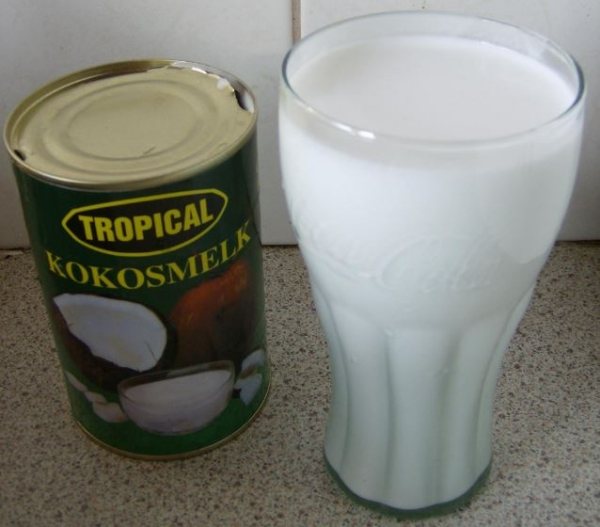
You can buy canned coconut milk at the store.
When studying the distribution of BJU in coconut milk, a conclusion arises about a high fat content:
- saturated fats – 21 percent;
- proteins –2.3 percent;
- carbohydrates –5.5 percent.
How is it useful?
A feature of coconut, which is noted by nutritionists, is the absence of cholesterol. This is proof of the benefits of coconut milk for the body. But consuming saturated fats causes the body to produce cholesterol on its own. This contradiction gives reason to think about the benefits of coconut milk.
Fats are a source of energy for the body; it needs them. They are usually found in animal products. Coconut milk, having an impressive range of vitamins and minerals, and also being a plant product, does the important job of saturating the body with essential fats.
The micro and macroelements present in milk affect the proper functioning of digestion and strengthens bone tissue.
What type of coconut milk is best to buy?
It's easy enough to make coconut milk at home, but if you prefer to buy pre-made varieties, look for the purest coconut milk you can. Always read the coconut milk label to ensure you are purchasing the highest quality milk. Look for coconut milk that is organic and contains no sugar or sweeteners, preservatives, artificial sweeteners, and is not pasteurized (which can potentially destroy some of the nutrients).
Is canned coconut milk harmful?
No—in fact, full-fat coconut milk is often sold in cans. Ideally, purchase coconut milk (organic if possible) that has been cold pressed. This means it has been gently heated and treated to remove certain bacteria, but has not been exposed to high temperatures that can deplete vitamins and minerals. Avoid purchasing any coconut milk (or water) that has been flavored with juices, sweeteners, colors or other ingredients. Better add your own healthy ingredients.
The main ingredient should be 100% coconut milk - and maybe a little coconut water. Some companies also add guar gum, which is a natural product used to stabilize the texture. Make sure the label states that the milk is unsweetened to avoid overdosing on sugar.
One final note: If you buy canned coconut milk, avoid cans made with a chemical called BPA. It is found in some aluminum cans and can cause certain health problems when leached into food (especially foods high in acid or fat, such as coconut milk). Look for an indication that the can is made without BPA and is “BPA free.”
Is there any harm from using it?
But the coin has two sides, so, in addition to the benefits, it is worth talking about the harm. With rapid absorption, allergic reactions occur as a result of consumption, which lead to complications. It is not suitable for those who suffer from fructose intolerance.
Young children are a direct contraindication for use due to the risk of allergies. Not suitable for people who are overweight. People suffering from atherosclerosis and high cholesterol should be careful when consuming coconut milk. Is it possible to be allergic to bananas?
Harm and contraindications
Coconut milk is rare in our diet, so the first time you need to consume it in a minimal amount to check if there is an allergic reaction. The fact is that on the shelves of our stores and supermarkets a canned product is sold, which in its properties and composition can differ greatly from the natural one. Artificial additives and stabilizers are often added to canned food, which certainly do not benefit the body.
Contraindications worth mentioning:
- fructose intolerance;
- tendency to digestive disorders;
- hyperfunction of the thyroid gland.
Overweight people should not consume virgin milk as it is very nutritious. It is better for them to dilute it with water or purchase a second-press product.
The product can be included in children's menus from the age of one, but do not use it too often.
How to do it at home?
The question arises of how to make coconut milk at home. Supermarkets most often sell canned products. Coconut milk and coconut water are not the same thing. The second is located directly inside the nut, and the first is artificially created from the pulp.
Is it possible to extract milk from coconuts yourself? The process seems complicated. Coconut's status as an exotic fruit leads to the fact that many are afraid to even think about how to make coconut milk themselves. There are only two ingredients for cooking:
Water is taken based on fat content.
- At the initial stage, the coconut is correctly and carefully split, and the juice and pulp are found inside. Juice is not involved in cooking.
- The pulp is crushed by grating or processing with a blender.
- The resulting mass is coconut flakes. The shavings are filled with water and left for half an hour.
- Then the mass is filtered.
- The resulting drink is poured into a suitable container. A glass of milk is usually prepared from one medium-sized coconut.
Review Reviews
Reviews about the use of coconut milk are numerous:
- found in many Korean and Japanese cosmetics;
- applicable for masks that promote cell regeneration and fight signs of aging;
- has the effect of creating a protective film, which resembles the result of a facelift.
It is known to use milk when working with hair. It is suitable for all hair types, does not damage the scalp even with prolonged use, fights dandruff and significantly improves appearance.
Coconut milk is widely used in cooking. For Asians, there is no question of what to make with coconut milk. Desserts based on it are famous all over the world. In addition to them, first courses are widespread. In Asian countries, milk is regularly made at home. A soup called “Tom Yam” is prepared on its basis and is very popular. Chicken Curry of the classic recipe is prepared with coconut milk.
Important. Storing milk in the refrigerator for more than two days is not recommended, but freezing will preserve all the nutritional properties. Coconut flakes are regularly used to make desserts. When specially dried, it has a long shelf life and also has the aroma and taste of coconut.
A coconut milk smoothie is considered a complete breakfast option for those who exercise or hope to replenish their body's energy reserves. It can be prepared with the addition of chia or flax seeds.
Composition and calorie content of coconut milk
Let's study the composition and calorie content of coconut milk. This product contains valuable Omega 3, 6 and 9 acids, as well as such useful components as:
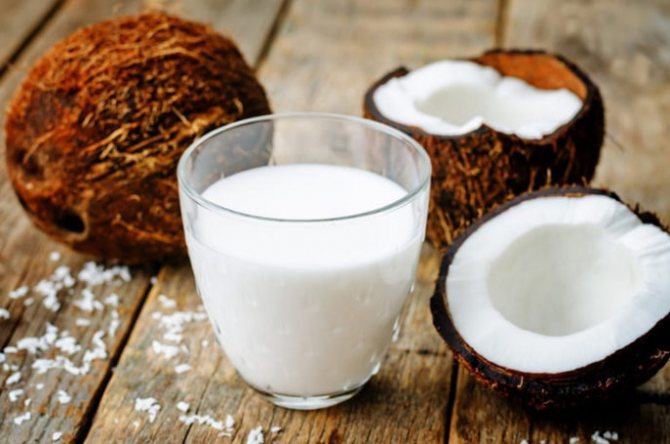
- organic acids;
- enzymes;
- B vitamins;
- a large set of microelements.
Natural fructose gives the sweet taste. The calorie content of the product is 163 kcal/100 ml.
Coconut milk benefits and harms
Let's take a closer look at coconut milk; the benefits and harms of this product are not known to everyone. We will talk about the benefits below, but first we will give contraindications for use:
- allergy;
- poor tolerance to fructose;
- hyperthyroidism;
- tendency to diarrhea.

You should also take into account the fact that we sell mainly canned milk, and it contains additives that reduce the benefits of the product.
The benefits of the product are as follows:
- dietary fiber normalizes digestion;
- antioxidants protect cells from destruction;
- the product improves immunity;
- helps strengthen the walls of blood vessels;
- increases vitality.
Alpro coconut milk: reviews
This product is loved by many. Customers call it “coconut-flavored milk replacer.” Indeed, this alternative to regular milk is perfect for people who, for whatever reason, cannot tolerate such products.
Those who have already tried this drink claim that it smells pleasant and has a sweetish, delicate taste. The product does not have chemical fragrances, and its smell is faint but pleasant.

The drink is white in color and has a completely thin consistency. In addition, consumers note that they love this product because it contains few calories (20 kcal per 100 ml).
Health benefits of coconut milk
The beneficial properties of coconut milk can be used to improve health. But we are talking only about a natural product; canned milk with artificial additives contains fewer nutrients.
When losing weight
Despite the fact that coconut milk is quite fatty, it is recommended to use it when losing weight. The fact is that vegetable fats are very beneficial for the skin. But you shouldn’t get carried away with drinking coconut milk; it’s quite high in calories.
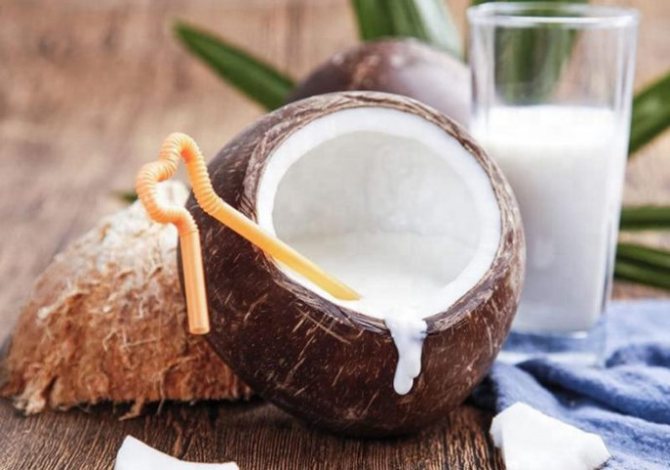
For allergies
It is recommended to consume coconut milk if you are allergic to cow's milk. But a negative reaction to the tropical fruit cannot be ruled out. Coconut allergy is uncommon, occurring in approximately 8 cases per 10,000 people. Coconut intolerance is often observed in people who are allergic to other types of nuts.
For immunity
The increased content of vitamins in coconut milk makes this product beneficial for the immune system. With its regular use, coughs and infectious diseases go away faster, and resistance to infections increases.
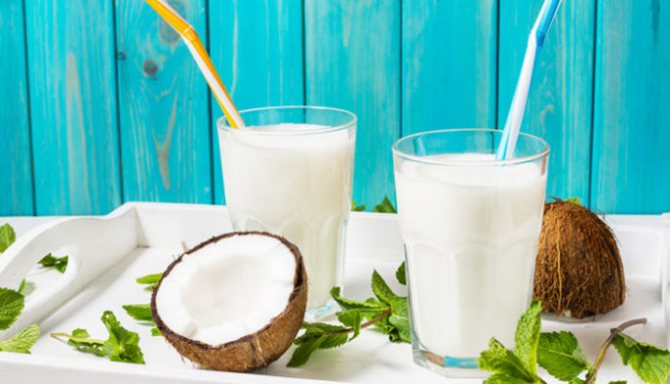
For the gastrointestinal tract
Coconut milk is very beneficial for the gastrointestinal tract. This product:
- helps with nausea, prevents dehydration;
- increases the rate of cell regeneration, promoting damage healing;
- stimulates intestinal function.
But if you have a stomach ulcer, you should not use this product due to the content of coarse fibers.
Losing weight with coconut milk
Milk obtained from coconut pulp is an effective means for losing weight. The rich composition, low calorie content and pleasant taste allow the product to be used in dietary nutrition. The diet can be built as follows:
- Breakfast: coconut (1/2 piece), coconut milk (150 ml).
- Lunch: boiled rice (100 g).
- Lunch: coconut (1/2 piece), coconut milk (150 ml).
- Afternoon snack: rice (80 g).
- Dinner: low-fat cottage cheese (100 g), coconut milk (150 ml).
The duration of the diet is no more than 7 days. According to reviews, this express method is easier to tolerate than other methods of weight loss. The effectiveness of the coconut diet is explained by the fact that the body receives substances that promote weight loss.
These include two components:
- Coconut oil (found in the fruit, 40% in coconut milk) is a source of fatty acids that stimulate weight loss and increase skin elasticity during weight loss.
- Fruit fiber. Filling the space of the stomach, it provides a long-lasting feeling of fullness.
The vitamins and minerals contained in coconut support the immune system and give energy during diet therapy. This diet is widespread in Thailand and other Asian countries.
Brands of coconut milk
Coconut milk is an exotic product for our latitudes; it can be purchased in canned form. The most popular brands of coconut milk are:
Fudo Coconut Milk
Fudo Coconut Milk is produced in Vietnam. Sold in 400 ml cans.

The mass is thick and creamy. To consume milk, you need to dilute it in hot water. After the milk is mixed with water, it will not look different from cow's milk, but it has a specific taste and aroma.
ICA Asia
The product, produced under the ICA Asia brand, is concentrated milk. It is diluted in hot water before use.
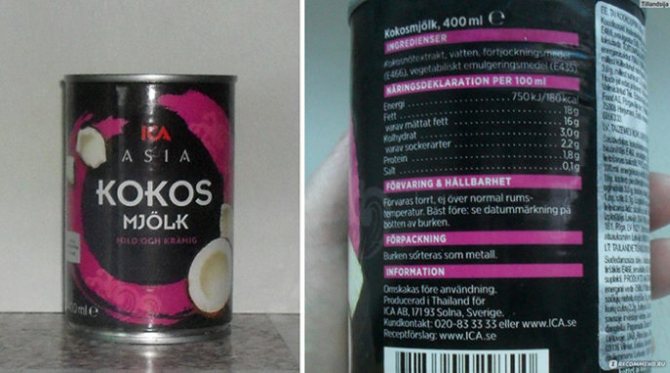
Sold in 400 ml cans. It has a pronounced coconut aroma and taste. The product is natural, but contains preservative and stabilizing additives.
Alpro Coconut
Alpro Coconut brand coconut milk is produced in Belgium. Sold in 1 liter tetra bags with a screw cap. In addition to coconut milk, it contains rice, calcium, stabilizer, vitamins B12 and D. Fat content - 0.9 g, protein - 0.1 g, carbohydrates - 2.7 g.

The product is thicker than cow's milk, the taste is sweetish, and the presence of rice flour is slightly noticeable. The coconut aroma is not too strong.
Sen Soy Coconut milk
An excellent product option is coconut milk from Sen Soy Coconut milk. Sold in 400 ml cans. The product label provides not only information about calorie content and composition, but also how to use milk.
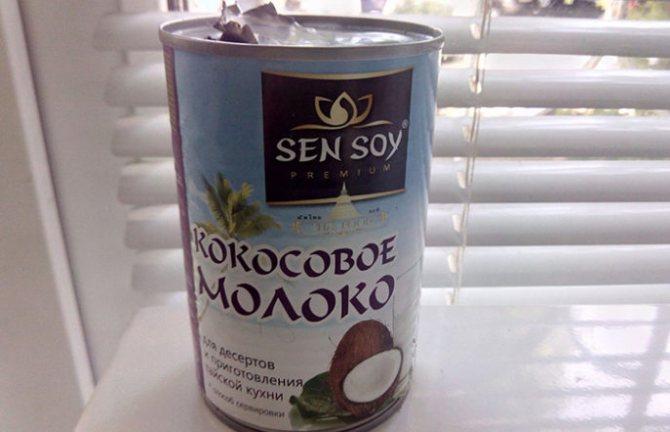
The milk is of good quality, its consistency is much thicker than cow's milk, and it has a pleasant coconut smell. The fat content of the product is 5-7%, this option is considered low-fat. Suitable for preparing desserts and Thai dishes.
How to make coconut milk
You can buy the product in canned form, or you can make it yourself. Let's figure out how to make coconut milk.
- Make a hole at the base of the nut with a knife and drain the juice;
- split the coconut into halves and then into smaller pieces;
- extract the pulp of the fruit, removing the dark skin;
- chop the pulp and grind in a blender with the addition of water (1 liter);
- Strain the prepared mixture and keep in the refrigerator for 5 days.
To prepare a more concentrated product (cream), you need to take half as much water.
Coconut milk in cosmetology
Coconut milk is used in cosmetology for hair and skin care. It is advisable not to use canned milk, as it may contain artificial additives.
For hair
Coconut milk is a true hair elixir. It can be used for laminating strands. Required:
- 3 tbsp. l. coconut milk;
- 1 tbsp. l. olive oil;
- 1 lemon;
- 1 tbsp. l. starch.

Squeeze the juice from the lemon, stir the starch in it. In another bowl, mix milk with butter. Then combine the mixtures and heat them on the stove, without bringing to a boil. Let cool. Apply the mixture to clean, damp hair and leave for 1.5 hours. Then rinse off the composition with shampoo and dry the strands without a hairdryer.
For face
Coconut milk is also good for the face, especially for dehydrated, dry and aging skin.

To prepare an effective mask, you need to mix equal volumes of coconut milk and honey. Soak cotton pads in the mixture and apply them to your face. After a quarter of an hour, remove the discs and wash.
Video
Several popular videos about coconut milk. About its benefits, harm and other interesting properties.

Share on social media networks:
Rate the material:
Ratings: 1 ( 5.00 out of 5)
Marina Kolesnichenko
16.12.2019
1937
0
Found a mistake? Select it and press Ctrl+Enter
Report a bug
Similar materials
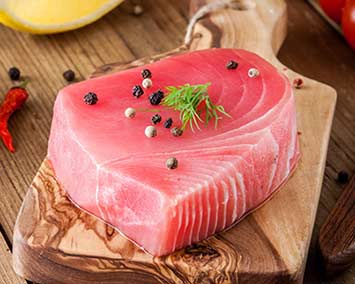
Tuna: beneficial properties and contraindications, composition, recipes
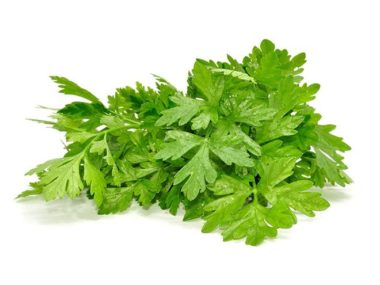
Parsley: beneficial properties and contraindications, composition, photos

Cheese: beneficial properties and contraindications, recipes, varieties

Linden honey: beneficial properties, contraindications, folk recipes

Cheese cheese: beneficial properties and contraindications, recipes, photos


